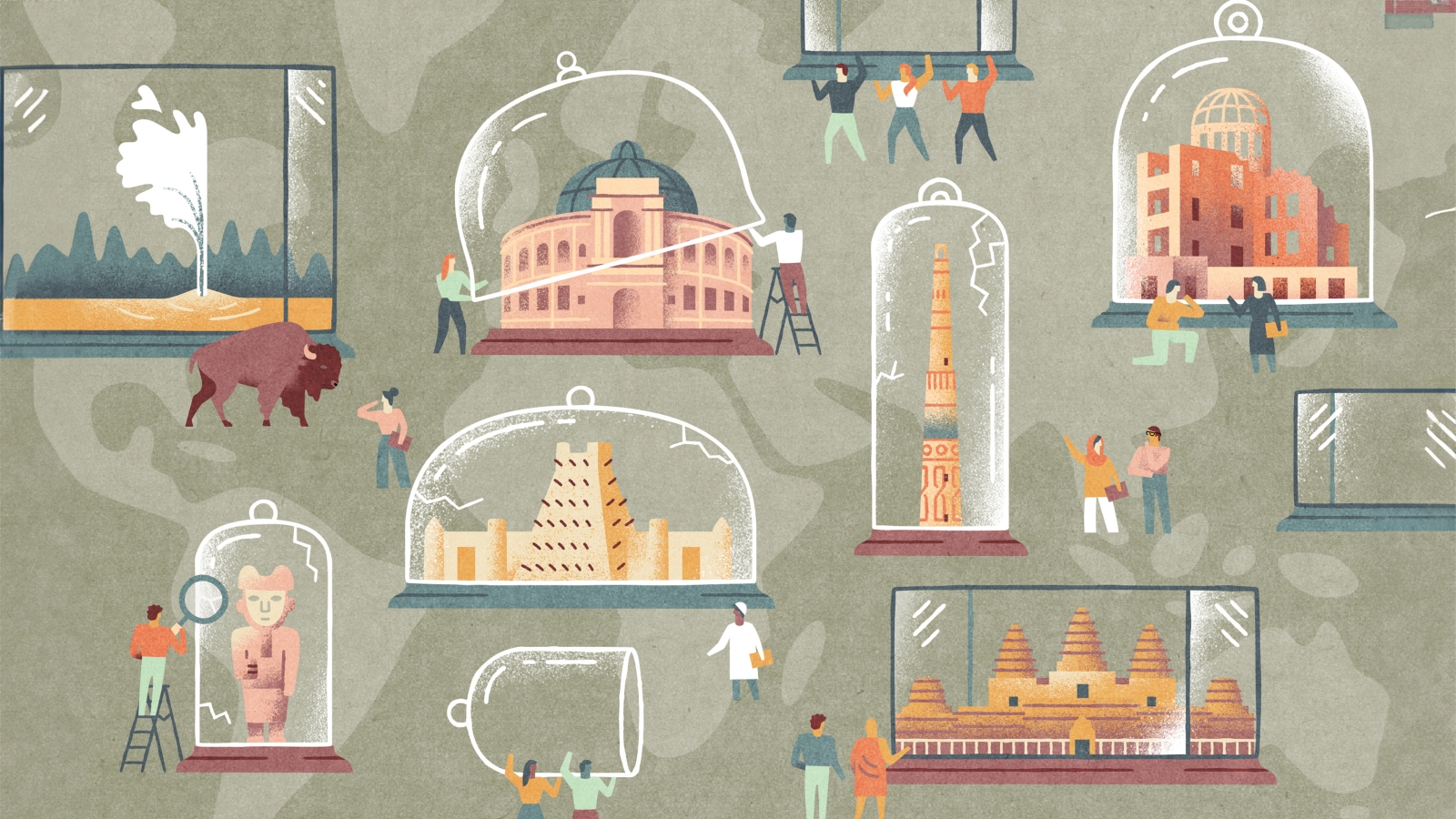Omnia 101: World Heritage Sites and Conflict
Archaeologist Lynn Meskell, Richard D. Green University Professor of Anthropology, discusses UNESCO and why places designated as cultural touchstones often signify much more.

Omnia 101 offers readers a peek into what faculty do every day in their classrooms and how their research and expertise are inspiring the next generation. The conversation with Professor Meskell took place before the start of the recent Israel-Hamas war.
The aim of UNESCO—the United Nations Educational, Scientific, and Cultural Organization—is to promote world peace and security through international cooperation in education, arts, sciences, and culture. It aims to do this through its World Heritage List, which provides legal protection to areas, landmarks, or sites deemed as having cultural, historical, scientific, or other forms of significance. But have these cultural touchstones come to signify more than culture, history, or science? How and why are the sites selected?

Lynn Meskell, Richard D. Green University Professor of Anthropology (Image: Eric Sucar/University Communications)
Lynn Meskell, Richard D. Green Professor of Anthropology, Historic Preservation, and City and Regional Planning, has studied UNESCO sites for more than a decade. Of late, she’s concluded that rather than the peace the World Heritage sites claim to foster, they’re actually exacerbating international conflict. We spoke with Meskell, also a curator at the Penn Museum, about her research on UNESCO, which informed her recent book, A Future in Ruins: UNESCO, World Heritage, and the Dream of Peace.
Why was UNESCO created?
UNESCO was formed in 1945 because of World War II. The idea was that the world needed rebuilding morally, educationally, and spiritually after the war ended, and UNESCO’s focus was on instilling peace and tolerance. The victors of the war came together with the mandate to “change the minds of men.” And of course, that’s why it seems so prescient now, 70 years on, that we are still grappling with intolerance and conflicts that target cultural heritage.
Has UNESCO been able to “change the minds of men”?
Sometimes it seems like we’ve learned little from UNESCO’s mission of world peace through shared culture and mutual understanding. UNESCO was initially focused on European civilization, but it quickly expanded because the destruction of heritage is everywhere. Unfortunately, there are plenty of conflicts to choose from around the world—Ukraine, China, Cambodia, Mali, Afghanistan, the Balkans—in which cultural heritage is being destroyed. Some of my current work looks at how cultural heritage is, in fact, targeted and weaponized in current and emerging conflicts.
How are World Heritage sites selected?
Individual countries strategically put forward sites for inclusion and today they are rarely, if ever, turned down. UNESCO has evaluators from all over the world, but all those evaluators can do is advise because this is an assembly of the United Nations, and it is state-party driven. A country like Myanmar or Thailand can nominate a site they think is on their land, or Rwanda can decide to nominate sites of genocide, even though that might create further tensions. It may take a year or two of lobbying, but nominating countries will often align with others and overturn expert decisions when it suits them.
Has a nominated site ever been denied?
At a minimum, the sites are meant to have “outstanding universal value.” A couple of years ago, evaluators decided that a site put forth by Saudi Arabia didn’t meet this threshold, yet it still ultimately got listed. Why? Because when the U.S. withdrew from UNESCO and its funding obligations, Saudi Arabia and other nations provided more money. And now, looking toward a post-oil future, Saudi Arabia is investing in heritage, heritage branding, and increasing tourism.
How does UNESCO approach conflicts around the world?
In the early years of the organization UNESCO was quite outspoken about occupied territories and protecting heritage, identifying those guilty of destructive acts. Unfortunately, now the organization has become more tentative about naming and shaming, although some might say they are bound by the constraints of diplomacy.
The fact is that UNESCO has been operating as a financially decimated organization since 2011 when the U.S. withdrew and took 22 percent of the budget with it. The U.S. is now formally back after a long absence and plans to slowly pay back its arrears, but the politics have really changed.
How are World Heritage sites being used as weapons in disputes between nations?
When UNESCO adds a site to the World Heritage List, it is legitimizing the nation or regime that “owns” that site. Cultural and archaeological heritage sites provide a means of making territorial claims or sovereignty claims, for example, in the South China Sea. There have also been disputes between Japan, China, and South Korea with regard to WWII sites or between Turkey and Armenia with contested territories. We’ve already had some inflammatory sites—sites of forced labor, for example—enshrined on the World Heritage List and we can expect more of that.
Why did UNESCO recently lift a moratorium on inscribing conflict sites?
Hiroshima and Auschwitz had been on the World Heritage List as sites of negative memory that should never be repeated. But then a moratorium was placed on adding any others. That’s changed recently, largely because Rwanda and other African nations want to enshrine sites of recent conflict and negative memory.
Where do you see UNESCO heading in the next decade?
There is still power in the brand. Despite the program’s shortfall in funds and staffing, almost every nation in the world still wants UNESCO recognition.



